รู้หรือไม่ ผู้สูงอายุวัย 65 ปีที่มีโรคเบาหวาน และโรคความดันโลหิตสูงเป็นโรคประจำตัว มีความเสี่ยงประมาณ 60% ที่จะเสียชีวิตหากป่วยด้วยโรค COVID-19 (ภาพที่ 1) โดยเราสามารถวิเคราะห์ผ่านเครื่องมือที่เรียกว่า Survival Rate Calculator
การคำนวนเหล่านี้สามารถทำได้โดยใช้ Big Data มาช่วยในการพยากรณ์โอกาสในการเสียชีวิต หรือกล่าวอีกนัยหนึ่งคือการคำนวณอัตราการรอดชีวิต (Survival Rate Calculator) จากการรายงานข่าวผู้เสียชีวิตจากโรค COVID-19 เรามักพบว่า ผู้เสียชีวิตเหล่านั้นมักมีโรคประจำตัวอย่างน้อย 1 โรค บทความนี้จะช่วยให้ท่านเข้าใจเหตุผลว่าทำไมถึงเป็นเช่นนั้น โดยอธิบายว่า Big Data ที่ใช้มีอะไรบ้าง การคำนวณเบื้องต้นทำได้อย่างไร
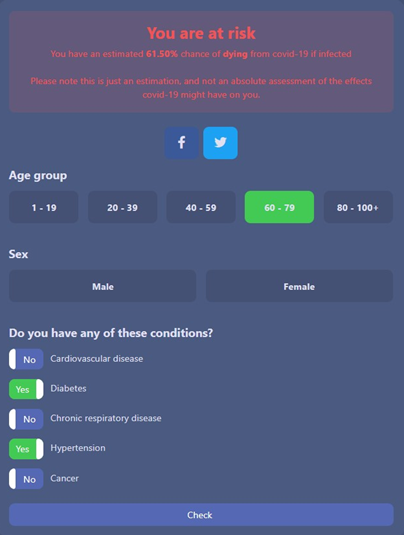
เว็บไซต์ Coronavirus Dashboard (ncov2019.live) นำเสนอการวิเคราะห์อัตราการเสียชีวิตของผู้ป่วยที่ติดเชื้อไวรัสโคโรนา โดยได้นำข้อมูลผู้ป่วยที่ผ่านการศึกษาปัจจัยที่เกี่ยวข้องกับการเสียชีวิตของผู้ป่วยโรคเดียวกันนี้ เพื่อคำนวณโอกาสในการเสียชีวิตที่จะเกิดขึ้นจากปัจจัยต่าง ๆ ได้แก่ ช่วงอายุ เพศ และโรคประจำตัว
Avi Schiffmann ผู้คิดค้น Survival Rate Calculator นี้ที่ใช้ในเว็บไซต์ดังกล่าวเป็นเพียงเด็กมัธยมปลายอายุ 18 ปี ซึ่งทำให้เราเห็นว่า Big Data ไม่ใช่เรื่องยากอย่างที่หลาย ๆ คนคิด ที่จริงแล้วใคร ๆ ก็สามารถทำได้

ในการเข้าใช้บริการ เราต้องป้อนข้อมูลช่วงอายุ เพศ และรายละเอียดเกี่ยวกับโรคประจำตัว (ถ้ามี) โดยผู้ที่มีความเสี่ยงสูงคือผู้ที่มีโรคประจำตัวได้แก่ โรคหลอดเลือดหัวใจ (Cardiovascular disease) โรคเบาหวาน (Diabetes) โรคระบบทางเดินหายใจเรื้อรัง (Chronic respiratory disease) โรคความดันโลหิตสูง (Hypertension) และโรคมะเร็ง (Cancer) ตัวอย่างหน้าจอในการป้อนข้อมูลแสดงดังภาพที่ 2
ตัวอย่างเช่น ชายอายุ 65 ปี ที่มีโรคประจำตัวคือ โรคเบาหวาน และโรคความดันโลหิตสูง ผลลัพธ์จากการคำนวณชี้ว่า ชายคนดังกล่าวมีความเสี่ยงในการเสียชีวิตหากเขาติดเชื้อ COVID-19 อยู่ที่ 63.34% ดังแสดงในภาพที่ 3

การวิเคราะห์อาศัยข้อมูลจาก COVID-19 #CoronaVirus Infographic Datapack — Information is Beautiful ซึ่งได้ทำการศึกษาวิจัยผู้ป่วยที่หายป่วยและเสียชีวิตจากโรค COVID-19 โดยจากการศึกษาพบว่า ผู้สูงอายุหรือผู้ที่มีอายุมากกว่า 60 ปี ถือเป็นกลุ่มที่มีความเสี่ยงสูง โดยเฉพาะช่วงอายุ 80-89 ปี และเพศชายมีความเสี่ยงมากกว่าเพศหญิงดังแสดงในภาพที่ 4 และภาพที่ 5 ตามลำดับ ภาพที่ 6 แสดงความเสี่ยงแยกตามโรคประจำตัวของผู้เสียชีวิต โดยผู้ที่มีความเสี่ยงในการเสียชีวิตมากที่สุดคือ ผู้ที่มีโรคหลอดเลือดหัวใจเป็นโรคประจำตัว รองลงมาคือโรคเบาหวาน โรคระบบทางเดินหายใจเรื้อรัง โรคความดันโลหิตสูง และโรคมะเร็งตามลำดับ หากผู้ป่วยรายใดมีโรคประจำตัวข้างต้นมากกว่า 1 โรค ความเสี่ยงในการเสียชีวิตก็จะเพิ่มมากยิ่งขึ้น โดยเฉพาะตั้งแต่ 3 โรคขึ้นไป จะมีความเสี่ยงสูงกว่า 50% ดังแสดงในภาพที่ 7 การมีโรคประจำตัวถือเป็นปัจจัยสำคัญ ตัวอย่างเช่น ผู้ที่มีอายุ 60 – 79 หากไม่โรคประจำตัวจะมีความเสี่ยงอยู่ 5% แต่หากผู้ติดเชื้อในช่วงอายุดังกล่าวมีโรคหลอดเลือดหัวใจเป็นโรคประจำตัว ความเสี่ยงจะมีสูงถึง 52.5%

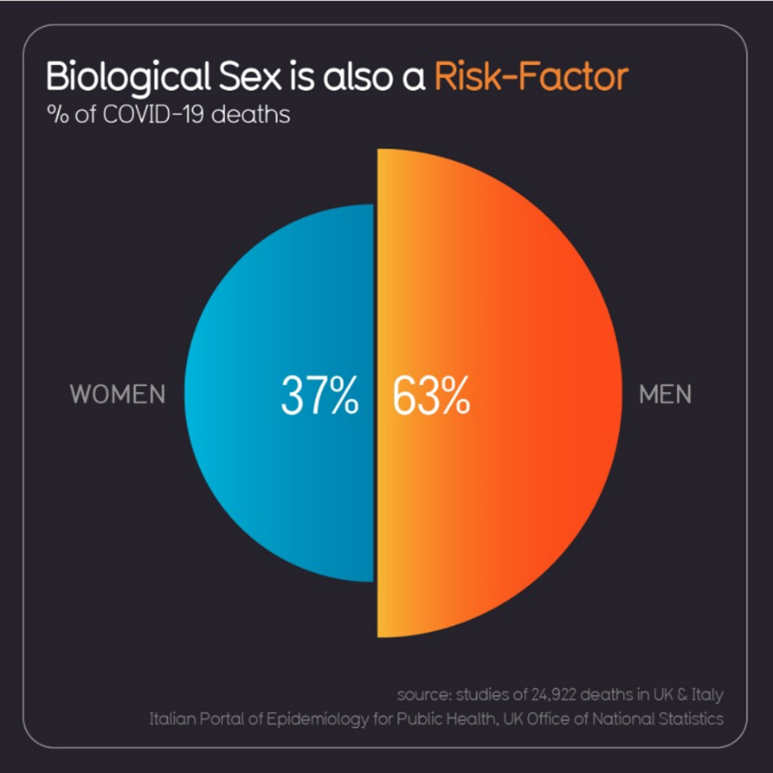
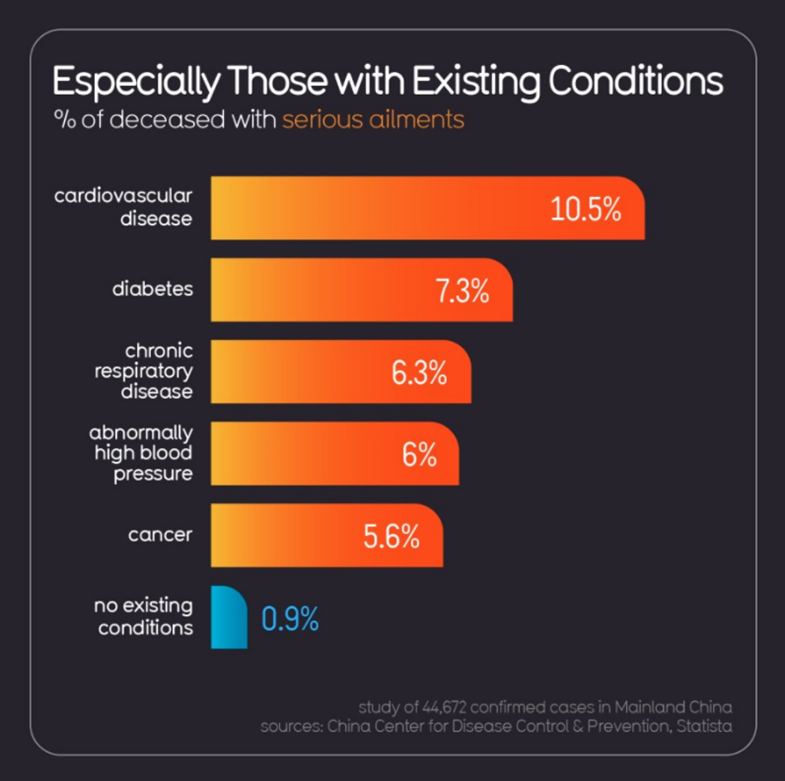
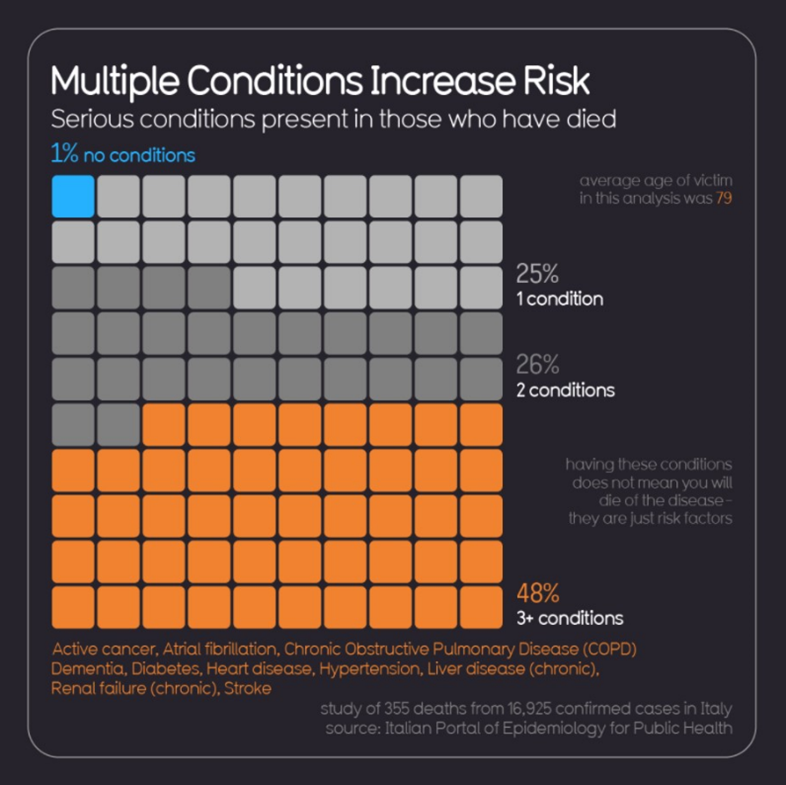
อย่างไรก็ตามการคำนวณครั้งนี้ใช้ Big Data ที่มีการศึกษาวิจัยในประเทศจีน อิตาลี และสหราชอาณาจักร มิได้ใช้ข้อมูลผู้เสียชีวิตจากไวรัสโคโรนาทั่วโลก และใช้เพียง 5 โรคที่มีสัดส่วนในการมีโรคประจำตัวดังกล่าวของกลุ่มตัวอย่างสูง แต่ก็สามารถใช้เป็นแนวทางในการเฝ้าระวังพิเศษโดยเฉพาะในประชาชนกลุ่มเสี่ยง ได้แก่ ผู้สูงอายุที่มีโรคประจำตัว เนื่องจากการติดเชื้อไวรัสโคโรนาจะมีความเสี่ยงในการเสียชีวิตสูง และหากมีโรคประจำตัวมากกว่า 1 โรค ก็จะยิ่งเพิ่มโอกาสในกาสเสียชีวิตให้สูงขึ้นอีกด้วย นอกจากนั้นแล้ว Survival Rate Calculator นี้อ้างอิงการคำนวณจากข้อมูลทางสถิติเท่านั้น ไม่ได้มีผลทางการแพทย์เข้ามาเกี่ยวข้อง สามารถใช้เครื่องมือในการประเมินเบื้องต้นได้ และนี่ก็เป็นอีกหนึ่งตัวอย่างของ Big Data กับการประยุกต์ใช้เกี่ยวกับโรค COVID-19
Reference
- Coronavirus Dashboard (ncov2019.live)
- COVID-19 #CoronaVirus Infographic Datapack — Information is Beautiful
Senior Data Management Training and Development Specialist at Big Data Institute (Public Organization), BDI
- Khwansiri Sirimangkhalahttps://temp.bdi.or.th/en/author/khwansiri-si/28 April 2025
- Khwansiri Sirimangkhalahttps://temp.bdi.or.th/en/author/khwansiri-si/24 October 2024
- Khwansiri Sirimangkhalahttps://temp.bdi.or.th/en/author/khwansiri-si/
- Khwansiri Sirimangkhalahttps://temp.bdi.or.th/en/author/khwansiri-si/













